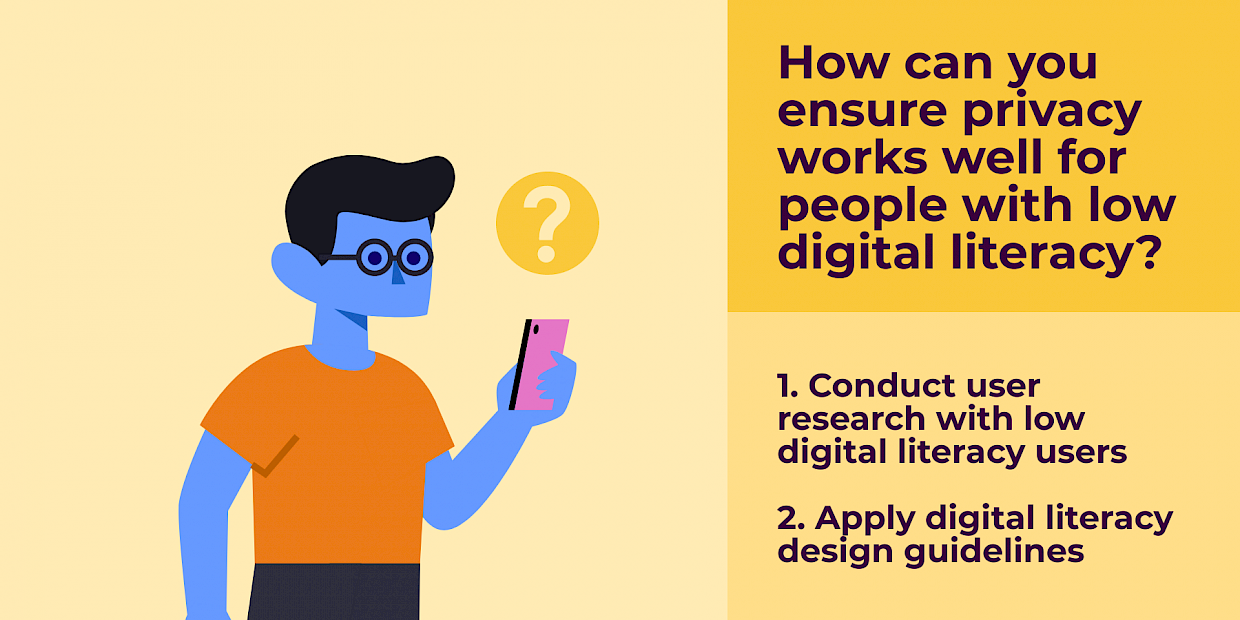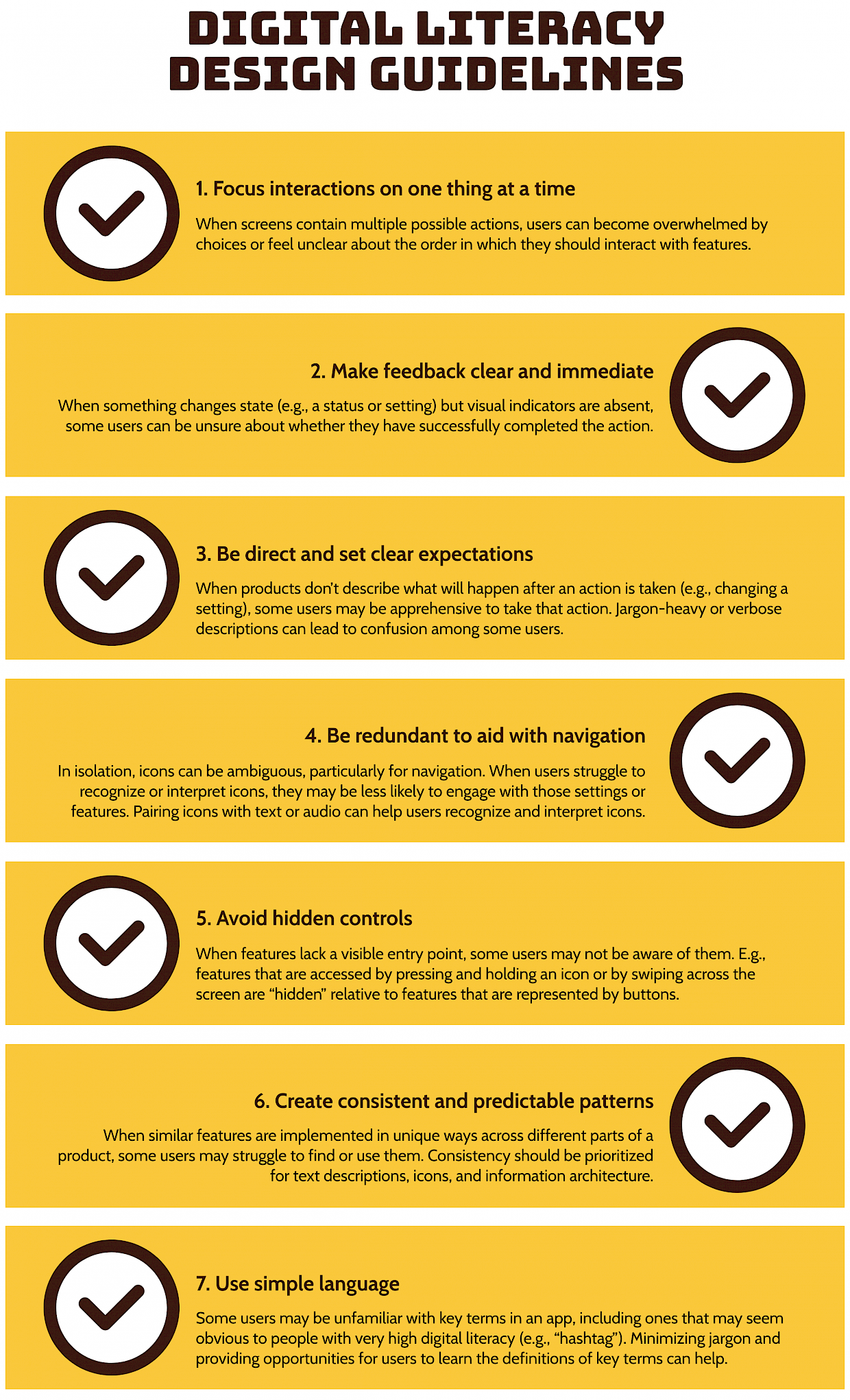Author’s note: Product teams at Facebook rely on research along with other external factors to design and build products. This article discusses research conducted or referenced by Facebook's Privacy Research Team to better understand the privacy needs of people with different levels of digital literacy.
Abstract
Ensuring that privacy features work well for people with low digital literacy can be a challenge in the context of current trends to create even more advanced (and therefore more complex) privacy controls.
In this article, we describe two strategies that Facebook’s Privacy Research Team has been using to address this: (1) Conducting privacy research with people who have low digital literacy, and (2) Applying research-backed digital literacy design guidelines to privacy features.
Report
“Digital literacy” refers to how well someone is able to understand, manage, and interact with information through digital technologies (Law et al., 2018). Perhaps unsurprisingly, digital literacy has important relationships with digital privacy (Büchi et al., 2017). For example, people with low digital literacy tend to have fewer privacy concerns and tend to use privacy features less frequently relative to people with high digital literacy (e.g., Baruh et al., 2017; Brough & Martin, 2020; Bartsch & Dienlin, 2016; Levin & Redmiles, 2021). Further, when people with low digital literacy do use privacy settings, they often lack confidence in their ability to use them effectively (Hargittai, 2010).
This relationship between digital literacy and privacy is critical for tech companies to consider when developing privacy experiences because a sizable portion of people who use a tech company’s products may have low digital literacy. For example, in a survey of people who use Facebook across 17 countries, between 24% to 41% of respondents had low digital literacy (Levin & Redmiles, 2021). Ensuring that privacy features work well for people with low digital literacy can be a challenge in the context of current trends to create even more advanced (and therefore more complex) privacy controls. As we continue to expand the privacy features available in Facebook’s products, our research teams have been using two strategies to promote positive privacy experiences for people with all levels of digital literacy.

Approach 1: Conducting privacy research with people who have low digital literacy
When we conduct user research studies to get feedback on privacy features, we often recruit participants who range from high to low digital literacy. This allows us to test how well different designs and experiences work for people across the digital literacy spectrum. For example, if we were conducting a usability test to update to a privacy setting, we might recruit 6 participants with low digital literacy and 6 participants with high digital literacy. We do this by pre-screening participants using validated digital literacy scales. One scale that some teams at Facebook have found to be useful is the Web Use Index scale, which asks respondents to self-report their level of understanding for a variety of digital technology terms such as “hashtag”, “bcc”, and “web feeds” using a 1-5 scale (Hargittai & Hsieh, 2011; Hargittai & Litt, 2013). Alternatively, in some cases it can be useful to measure comprehension of digital technology terms using quiz style questions rather than relying on self-reported understanding (for examples of this type of scale see Olmstead & Smith, 2017 and Vogels & Anderson, 2019). By deliberately recruiting participants with low and high digital literacy for our user research studies, we find that we’re often able to identify important opportunities to improve our privacy experiences for everyone.
Approach 2: Applying digital literacy design guidelines to privacy experiences
Based on research and subject matter expertise, a cross-disciplinary team of Facebook researchers and designers have developed a set of seven digital literacy design guidelines that we use within the company to help make products easier to use for people with all levels of digital literacy. Our privacy research and design teams have been incorporating these guidelines into heuristic evaluations of privacy features, and the results have helped to improve privacy experiences across Facebook’s products.

These guidelines aren’t hard-and-fast rules, but rather a useful starting point to help ensure that products (including privacy features) will work well for people with low digital literacy. Ultimately, it’s best to pair the application of these guidelines with additional product-specific user research when possible.
A call to action
As tech companies continue to improve their privacy experiences, it’s critical to ensure that users with low digital literacy don’t get left behind. However, this is challenging in the context of current trends to create more advanced privacy controls. At Facebook, we’ve been approaching this in a variety of ways, including using the strategies outlined in this article — applying research-backed digital literacy design guidelines and deliberately sampling users with low digital literacy when conducting user research about privacy features. We encourage other tech companies to adopt similar practices in order to help ensure that their users with low digital literacy are able to have positive privacy experiences.

